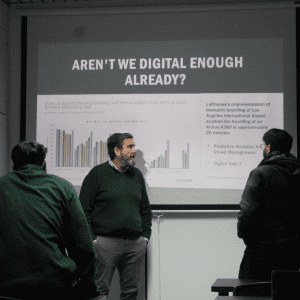
Update from the Chancellor – Bottlemoney
29. October 2024
A personal Update from the Chancellor – 10 Years New European College
11. February 2025Context
Airports have undergone a significant transformation over the past few years, especially in response to challenges like the pandemic and the growing demand for technological advancements. Let’s explore how these changes are shaping the airport experience.
First, it’s important to understand the global scale of airport operations. The industry took a massive hit during the pandemic, with revenues dropping to just $161 billion in 2020. However, recovery has been steady, with figures now reaching $239 billion in 2022 and projected to grow further. For context, Saudi Arabia’s King Fahd International Airport, the largest globally by land area, exemplifies the scale and infrastructure of modern airports.
The pandemic didn’t just impact finances—it reshaped passenger expectations. With concerns around safety and health, airports had to adapt quickly. Technologies like thermal scanners and biometrics became essential, with over 80% of travelers expressing that these measures significantly boosted their confidence. Similarly, staggered boarding processes and distanced seating on flights emerged as crucial steps to reassure passengers.
Technology has become a cornerstone of the airport experience. We’ve seen a shift towards self-service options, such as automated bag drops, which are now available at over half of airports worldwide. Mobile applications for check-ins and notifications are also gaining traction, replacing traditional methods. By 2024, it’s expected that three-quarters of airports will offer unassisted bag drops, showing how digital solutions are taking center stage. However, challenges like baggage mishandling remain, costing the industry millions each year. On a brighter note, investments in artificial intelligence (AI) and business intelligence (BI) systems are paving the way for smarter operations. These technologies are being deployed to improve everything from aircraft turnaround times to personalized passenger experiences.
Looking ahead, the focus is on innovation and security. Cybersecurity is a top investment priority for airports as they digitize further. Additionally, future-ready technologies like 5G, biometric ID management, and AI applications are expected to redefine how we travel.
About the Munich Airport
The Munich Airport Integrated Report 2023 provides a comprehensive overview of the airport’s operations, financial performance, sustainability efforts, and strategic development. Key highlights include:
Economic and Operational Performance:
- Passenger numbers rebounded to 37 million in 2023, reaching 80% of pre-crisis levels from 2019.
- Record seat occupancy of 81.3% was achieved.
- Group revenue increased by 15.6%, reaching €1.373 billion, and net profit returned with €25.4 million after taxes.
- Significant recovery in long-haul and intercontinental routes.
Sustainability Goals:
- Commitment to achieving net-zero CO₂ emissions by 2035, focusing on reducing emissions by 90% and removing the remainder through innovative projects like climate forests and carbon capture technologies.
- Investments in energy efficiency, such as LED lighting, alternative fuels, and photovoltaic systems.
Strategic Projects:
- Expansion of Terminal 1 and modernization of facilities, including innovative digital solutions like smart baggage trolleys and CT scanners for security.
- Development of LabCampus as an innovation hub, fostering collaboration across industries.
Employee and Social Aspects:
- Increased recruitment efforts, adding 1,500 employees in 2023.
- Emphasis on digitalization and remote working flexibility to adapt to new workforce expectations.
- Expansion of HR marketing initiatives to address the competitive labor market.
Infrastructure and Partnerships:
- Joint sustainability and digitalization strategies with Lufthansa.
- Continued investments in cargo and logistics, benefiting from strategic long-haul routes.
Challenges and Achievements:
- Recovery was tempered by global crises, labor shortages, and supply chain issues.
- Munich Airport was named the “Best Airport in Central Europe” and maintained its 5-star Skytrax rating.
The report underscores the airport’s efforts to position itself as a sustainable, innovative, and premium European hub, with a strong focus on environmental responsibility, economic recovery, and enhancing passenger experiences.
Purpose of the project
During this project week, students will analyze a comprehensive business case focusing on Munich Airport (MUC), Germany’s second-busiest airport and a major European hub. The case combines market research, strategic marketing, and operational excellence analysis with practical insights gained from an on-site visit to understand airport operations and develop solutions for current challenges.
Evaluation Process
1. Depth and Quality of Research
2. Critical Analysis and Insight
3. Clarity and Structure
4. Application of Theoretical Concepts
5. Originality and Creativity
6. Pitch Presentation
7. Presentation














